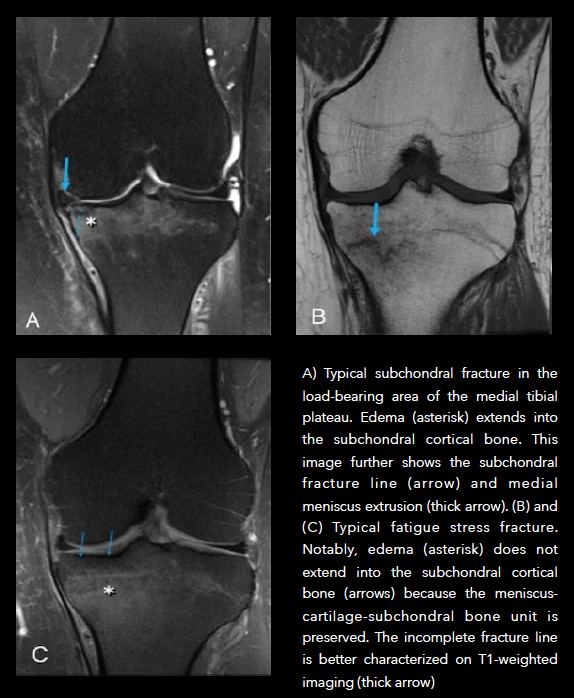IO-Core Bone Marrow Injections
Minimally Invasive biologic and structurally supported treatment of Bone Marrow Lesions/Edemas, Cysts, Insufficiency Fractures and cartilage lesions.
IO-Core Procedure
Treatment technique utilizing biologics to decompress pain inducing lesions, edemas, cysts, insufficiency fractures by introducing high quality autologous biologic material to accelerate and promote healing of damaged subchondral bone and degenerating cartilage.
Bone pathologies resulting from acute or chronic injury, including bone marrow lesions and osteonecrosis of the knee, cause severe pain and disability. Chronic swelling of the bone underneath cartilage is painful and can be a sign of chronic overload. It can also be a sign of lack of oxygen to the bone called avascular necrosis. The majority of these patients progress rapidly from initial diagnosis to total knee replacement surgery.
IO-Core procedure is the newest treatment progression for osteoarthritic pain associated with Bone Marrow Lesions. This comprehensive and all-natural approach to healing combines a core decompression, an intraosseous injection of autologous BMA, and placement of autologous bone dowel. As previous studies have shown: core decompression will relieve edema and allow healthy blood flow back into the area, Bone Marrow Aspirate Concentrate provides the
necessary regenerative cells for osteoinduction, and an intact bone core/dowell provides a healthy scaffold/surface for osteoconduction (new healthy bone growth).
• Core decompression is the procedure that relieves pressure by drilling directly into injury site.
• Studies have shown a strong correlation to the number of CFU-F and positive clinical outcomes. The higher the CFU-F counts in bone marrow samples means stronger clinical outcomes (Hernigou et al (2005).
• Aspirating high quality marrow and combining with a functioning scaffold for transplantation into a bone defect (Bone Marrow Lesion) replicates the body’s natural healing response at the treatment site.
• Intact bone core/dowel is an autograft harvested from the iliac crest or long bone in a less invasive manner. Harvesting an intact bone core avoids donor site morbidity previously associated with ICBG. These grafts integrate better and support the bone modeling process needed for healing. Previous studies have demonstrated that autograft combination with cellular graft bone marrow aspirate (containing high MSC count) better supports bone healing as compared to graft alone.

IO-Core osteochondral defect procedure provides surgeons with the highest quality autologous biologics and technique to treat patients suffering from debilitating pain caused by bone marrow lesions, edemas, cysts, insufficiency fractures associated with acute and/or chronic injuries such as osteoarthritis.
Contact Us to Learn More About IO-Core Bone Marrow Injections

IO-Core Bone Marrow Injections Treat Osteoarthritis
The IO-Core Bone Marrow Injections combines the most advanced regenerative medicine techniques available in medicine including Platelet Rich Plasma (PRP) and Bone Marrow Aspirate. These approaches involve a core decompression, injection of autologous bone marrow aspirate or platelet-rich plasma, and the placement of an autologous bone dowel graft.
Core decompression is a process where the physician extracts the part of the bone that is damaged. This allows the surgeon to leave the healthy bone intact while removing the portions that are causing your Osteoarthritis pain and prevent further damage. A core decompression reduces pressure in the bone, improves blood flow to the area to stimulate the healing process, and will preserve healthy bone tissue from deteriorating.
The extracted sections of bone is then filled in using an allograft or autograft of demineralized bone matrix. This matrix can be combined with either platelet rich plasma or bone marrow aspirate. Both of these options contain important growth factors and proteins that have potential to accelerate the healing process and restore to a healthy function while generating new tissue and reducing scar tissue formation. The bone matrix combined with one of these Regenerative medicine techniques allows quick regrowth of the bone to promote a healthier joint.
Once the new matrix core is ready, it is placed in the joint to provide a scaffold for the new bone growth. This bone core is harvested from a person’s own body, with the most common area being the iliac crest on the top of the hip bone. By obtaining the bone core from the patient’s own body, it prevents any potential issues with rejection or compatibility issues that may be seen with donor tissues. This bone core serves as a graft that allows the bone remodeling process to work more efficiently and attach to the current, healthy bone more effectively.
References
1. Astur et al. (2018) Evaluation and Management of Subchondral Calcium Phosphate
Injection Technique to Treat Bone Marrow Lesion. Cartilage. 2018 Apr 1:1947603518770249
https://www.ncbi.nlm.nih.gov/pubmed/29667853
2. Bonadio et al. (2017) Subchondroplasty for treating bone marrow lesions in the knee –
initial experience. Rev Bras Ortop. 2017 Apr 28;52(3):325-330
https://www.ncbi.nlm.nih.gov/pubmed/28702392
3. Chatterjee et al. (2015) Subchondral Calcium Phosphate is Ineffective for Bone Marrow
Edema Lesions in Adults With Advanced Osteoarthritis. Clin Orthop Relat Res. 2015 Jul; 473(7):2334-42
https://www.ncbi.nlm.nih.gov/pubmed/25917421
4. Cohen et al (2016) Subchondroplasty for Treating Bone Marrow Lesions. J Knee Surg.
2016 Oct;29(7):555-563. Epub 2015 Dec 7.
https://www.ncbi.nlm.nih.gov/pubmed/26641077
5. Colon et al. (2015) Assessment of the injection behavior of commercially available bone
BSMs for Subchondroplasty® procedures. Knee. 2015 Dec;22(6):597-603
https://www.ncbi.nlm.nih.gov/pubmed/26213362
6. Eriksen et al. (2015) Treatment of bone marrow lesions (bone marrow edema). Bonekey
Rep. 2015 Nov 25;4:755
https://www.ncbi.nlm.nih.gov/pubmed/26644910

